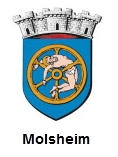PARTNER MUNICIPALITIES
 Balbronn
BalbronnA wine-growing town with over 650 inhabitants, Balbronn is located 25 km west of Strasbourg and is part of the Molsheim district. Already in Merovingian times Balbronn was of some importance, the village being situated on the old road linking the Merovingian palace to the hermitage of Niederhaslach, today called the Holzweg (d'r holzwaj).
The name of the village is said to be of 'Frankish' origin, Baldeburne, this people worshipped the springs, "Burne, Bronn".
Originally, the church was fortified. A sentry walk can still be seen to the north. Balbronn had a castle located outside the fortifications of the. The castle is mentioned in the 15th century. It served as the residence of the bailiff. It was about 20m x 20m, flanked by 4 towers and a drawbridge. After the Thirty Years' War, it became increasingly dilapidated and was demolished in the early 19th century.
 Blienschwiller
BlienschwillerBlienschwiller is a commune in the Bas-Rhin department in Alsace in northeastern France.
For more information...
 Bourgheim
BourgheimBourgheim, a small village with a long history. Situated on the banks of the Kirneck on a loessic terrace overlooking the Bruch de l'Andlau, the site has been inhabited since Gallo-Roman times. The ruins of the fortress (burgus), which protected the road and the Kirneck watchtower, served as a base for the construction of the Romanesque church in the 12th century. Archaeological excavations have uncovered numerous remains of potters' settlements from Roman times. During the Carolingian period, potters and glassmakers settled in the village.
Vines have long been cultivated on the slopes of the Piedmont, with cereals and tobacco occupying the lowlands. Since 1954, the local agricultural machinery manufacturing company has had a significant economic and social impact on the development of the village.
 Flexbourg
FlexbourgFlexbourg, a small village of 490 inhabitants, is situated in the hills of the Vosges, at the bottom of a semi-circular valley. The relief around the village is still very marked by the numerous gypsum quarries that were very active until the end of the 19th century. The commune has a vineyard of 3.5 hectares classified as AOC, included in the “Syndicat du vignoble de la Couronne d'Or” of which it is one of the geographical gateways.
The church of ST HIPPOLYTE was built in 1888 in the neo-Romanesque style with a proud 42 m bell tower that dominates the hills. Listed in the general inventory of cultural heritage, the building of the old school, on the church square, contains remains of the 14th century. The village has some remarkable houses: rue des Seigneurs, small half-timbered houses from the end of the 17th century, a large mansion with a French roof from the end of the 17th century and the former presbytery, the home of a wealthy winegrower built in 1809.
 Gertwiller
GertwillerGertwiller, a wine-growing commune and gingerbread capital, is a village of 1291 inhabitants, situated at the foot of Mont Sainte Odile.
The first known traces of gingerbread date from 1789, imported from Nuremberg. The know-how of the confectioners in this village, situated between the plains and the wine-growing hills, has contributed to making gingerbread a regional gastronomic specialty. Today two companies have continued the tradition.
The Gertwiller vineyard covers some 120 ha, is protected from the prevailing winds by the Vosges mountains, in particular the Maennelstein, and faces south-south east. The clay-siliceous soil allows the production of all the Alsatian grape varieties. Gertwiller benefits from the production rights of Klevener de Heiligenstein. The village now has 16 winegrowers.
 Goxwiller
GoxwillerGoxwiller is a street village, in contact with the agricultural plain and the wine-growing foothills. It is a lowland wine-growing village.
You can admire an old wine press from the 12th century and several public wells, two of which date from the 16th century.
Goxwiller is also the village of wells.
The inventory of architectural heritage shows that Goxwiller is the village in the canton of Obernai that has kept the most wells in place. They are made of sandstone, with circular or square coping walls, superstructures with external posts and straight or arched lintels. The pulleys are made of wood or iron. Some of them bear the date of their installation: 1585, 1712, 1750, 1863, 1867.
The oldest well in the Commune is dated 1585 and bears the arms of the town of Strasbourg, the lord of the village, and the arms of Goxwiller on the curved lintel; the mark of a craftsman and rosettes.
Hélène DE BEAUVOIR, sister of the famous painter Simone DE BEAUVOIR, lived in her house in Goxwiller for 20 years until her death in 2000.
 Heilligenstein
HeilligensteinSituated at the foot of Mont Saint-Odile, Heiligenstein is best known for its "Klevener", a grape variety unique to Alsace. Its wine-making vocation dates back to the 3rd century, to Roman times.
The remote origin of the village, perched at an altitude of 250 meters between vineyards and forest, remains a mystery to this day. It took its present name in 1460.
This flowery village enjoys an exceptional location for hiking enthusiasts. It is the starting point of many circuits which allow you to discover breathtaking views of the Alsace Plain. The most courageous hikers can follow the trails of the Club Vosgien to visit, among other things, the Landsberg castle, the pagan wall, the Mont Sainte-Odile...
 Nothalten
NothaltenNothalten is a commune in the Bas-Rhin department in Alsace in north-eastern France.





























































